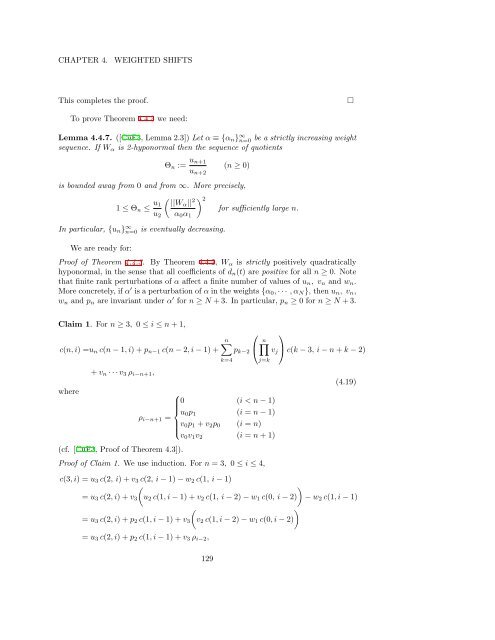Woo Young Lee Lecture Notes on Operator Theory
Woo Young Lee Lecture Notes on Operator Theory
Woo Young Lee Lecture Notes on Operator Theory
Create successful ePaper yourself
Turn your PDF publications into a flip-book with our unique Google optimized e-Paper software.
CHAPTER 4.<br />
WEIGHTED SHIFTS<br />
This completes the proof.<br />
□<br />
To prove Theorem 4.4.3 we need:<br />
Lemma 4.4.7. ([CuF3, Lemma 2.3]) Let α ≡ {α n } ∞ n=0 be a strictly increasing weight<br />
sequence. If W α is 2-hyp<strong>on</strong>ormal then the sequence of quotients<br />
Θ n := u n+1<br />
u n+2<br />
(n ≥ 0)<br />
is bounded away from 0 and from ∞. More precisely,<br />
1 ≤ Θ n ≤ u 1<br />
u 2<br />
( ||Wα || 2<br />
α 0 α 1<br />
) 2<br />
for sufficiently large n.<br />
In particular, {u n } ∞ n=0 is eventually decreasing.<br />
We are ready for:<br />
Proof of Theorem 4.4.3. By Theorem 4.4.2, W α is strictly positively quadratically<br />
hyp<strong>on</strong>ormal, in the sense that all coefficients of d n (t) are positive for all n ≥ 0. Note<br />
that finite rank perturbati<strong>on</strong>s of α affect a finite number of values of u n , v n and w n .<br />
More c<strong>on</strong>cretely, if α ′ is a perturbati<strong>on</strong> of α in the weights {α 0 , · · · , α N }, then u n , v n ,<br />
w n and p n are invariant under α ′ for n ≥ N + 3. In particular, p n ≥ 0 for n ≥ N + 3.<br />
Claim 1. For n ≥ 3, 0 ≤ i ≤ n + 1,<br />
c(n, i) =u n c(n − 1, i) + p n−1 c(n − 2, i − 1) +<br />
where<br />
+ v n · · · v 3 ρ i−n+1 ,<br />
(cf. [CuF3, Proof of Theorem 4.3]).<br />
n∑<br />
k=4<br />
p k−2<br />
⎛<br />
⎝<br />
n∏<br />
j=k<br />
⎧<br />
0 (i < n − 1)<br />
⎪⎨<br />
u 0 p 1 (i = n − 1)<br />
ρ i−n+1 =<br />
v 0 p 1 + v 2 p 0 (i = n)<br />
⎪⎩<br />
v 0 v 1 v 2 (i = n + 1)<br />
Proof of Claim 1. We use inducti<strong>on</strong>. For n = 3, 0 ≤ i ≤ 4,<br />
v j<br />
⎞<br />
⎠ c(k − 3, i − n + k − 2)<br />
(4.19)<br />
c(3, i) = u 3 c(2, i) + v 3 c(2, i − 1) − w 2 c(1, i − 1)<br />
)<br />
= u 3 c(2, i) + v 3<br />
(u 2 c(1, i − 1) + v 2 c(1, i − 2) − w 1 c(0, i − 2) − w 2 c(1, i − 1)<br />
)<br />
= u 3 c(2, i) + p 2 c(1, i − 1) + v 3<br />
(v 2 c(1, i − 2) − w 1 c(0, i − 2)<br />
= u 3 c(2, i) + p 2 c(1, i − 1) + v 3 ρ i−2 ,<br />
129













